Embracing the Spectrum: Understanding Autism Spectrum Disorder (ASD)
Introduction: Autism Spectrum Disorder (ASD) is a neurodevelopmental condition that affects individuals across the lifespan, presenting a wide range of strengths, challenges, and unique perspectives. As we explore the world of ASD, let us embark on a journey to gain a deeper understanding of this complex condition from a psychological perspective. In this blog, we will delve into the diverse characteristics of ASD, its impact on individuals' lives, and the importance of fostering acceptance, support, and inclusivity.
1. Unveiling the Spectrum: Diverse Characteristics of ASD: The autism spectrum encompasses a rich tapestry of diverse characteristics. Individuals with ASD may exhibit differences in social communication, repetitive behaviors, sensory sensitivities, and cognitive processing. Understanding the variations within the spectrum is key to appreciating the unique strengths and challenges that individuals with ASD possess.
2. Nurturing Social Connections: Social interactions can present hurdles for individuals with ASD, who may struggle with social communication, understanding nonverbal cues, and building relationships. Embracing a supportive environment that promotes inclusive practices, educating peers about autism, and providing social skills training can help individuals with ASD cultivate meaningful connections and foster a sense of belonging.
3. Sensory Sensitivities and Sensory-Friendly Approaches: Many individuals with ASD experience heightened or diminished sensitivity to sensory stimuli. Creating sensory-friendly environments, incorporating visual supports, and offering accommodations tailored to individual needs can help alleviate sensory overwhelm and facilitate comfort, enhancing overall well-being and participation.
4. Enhancing Communication and Language Skills: Communication differences are a hallmark of ASD. Some individuals may struggle with spoken language while excelling in other forms of communication such as nonverbal cues, augmentative and alternative communication (AAC), or visual supports. Implementing person-centered communication strategies, embracing diverse modes of expression, and fostering a communication-friendly environment can empower individuals with ASD to effectively express themselves.
5. Supporting Transitions and Daily Routines: Changes in routines or transitions can be challenging for individuals with ASD, who often thrive in structured and predictable environments. Offering visual schedules, clear expectations, and gradual transitions can help ease anxiety and facilitate smoother transitions in various settings, including home, school, and community.
Conclusion: Autism Spectrum Disorder is a unique and diverse condition that warrants understanding, acceptance, and support. By embracing the spectrum and recognizing the strengths and challenges of individuals with ASD, we can create inclusive environments that celebrate neurodiversity. Let us join hands to foster empathy, spread awareness, and advocate for an inclusive society where every individual, regardless of their place on the spectrum, can thrive and reach their full potential.
DISCLAIMER: THIS BLOG IS INTENDED FOR INFORMATIONAL PURPOSES ONLY AND SHOULD NOT BE CONSIDERED A SUBSTITUTE FOR PROFESSIONAL ADVICE OR DIAGNOSIS. IF YOU SUSPECT THAT YOU OR SOMEONE YOU KNOW MAY HAVE ASD OR REQUIRE GUIDANCE IN SUPPORTING INDIVIDUALS WITH ASD, IT IS RECOMMENDED TO CONSULT WITH A QUALIFIED HEALTHCARE PROFESSIONAL OR PSYCHOLOGIST FOR A COMPREHENSIVE EVALUATION AND PERSONALIZED RECOMMENDATIONS.